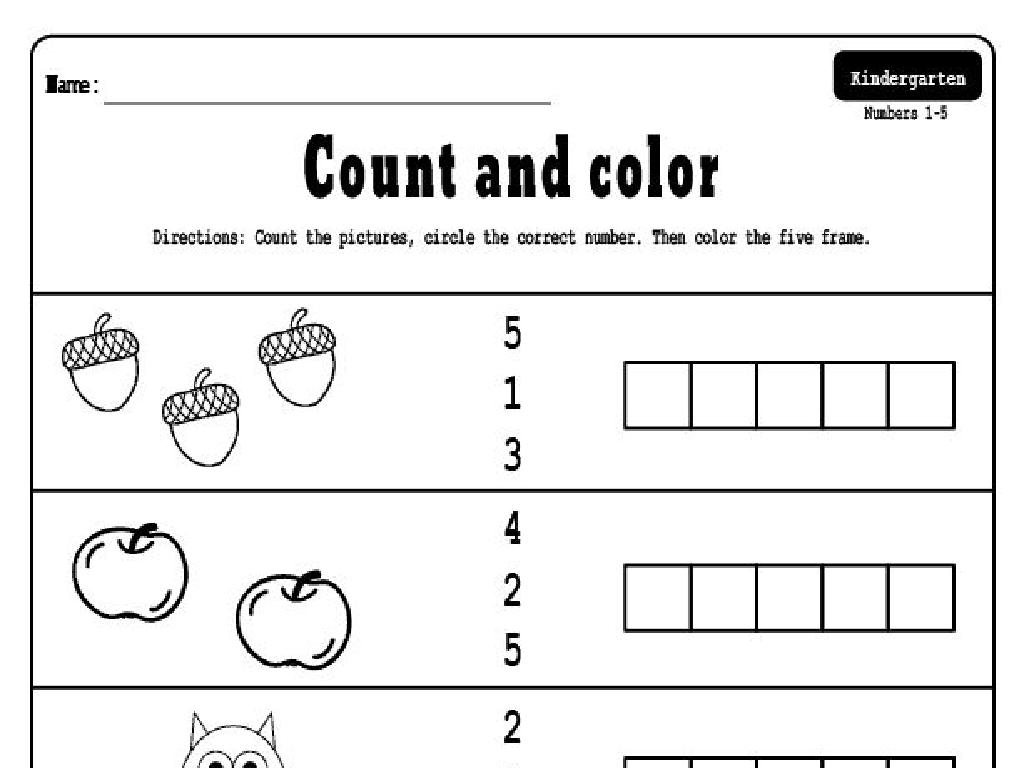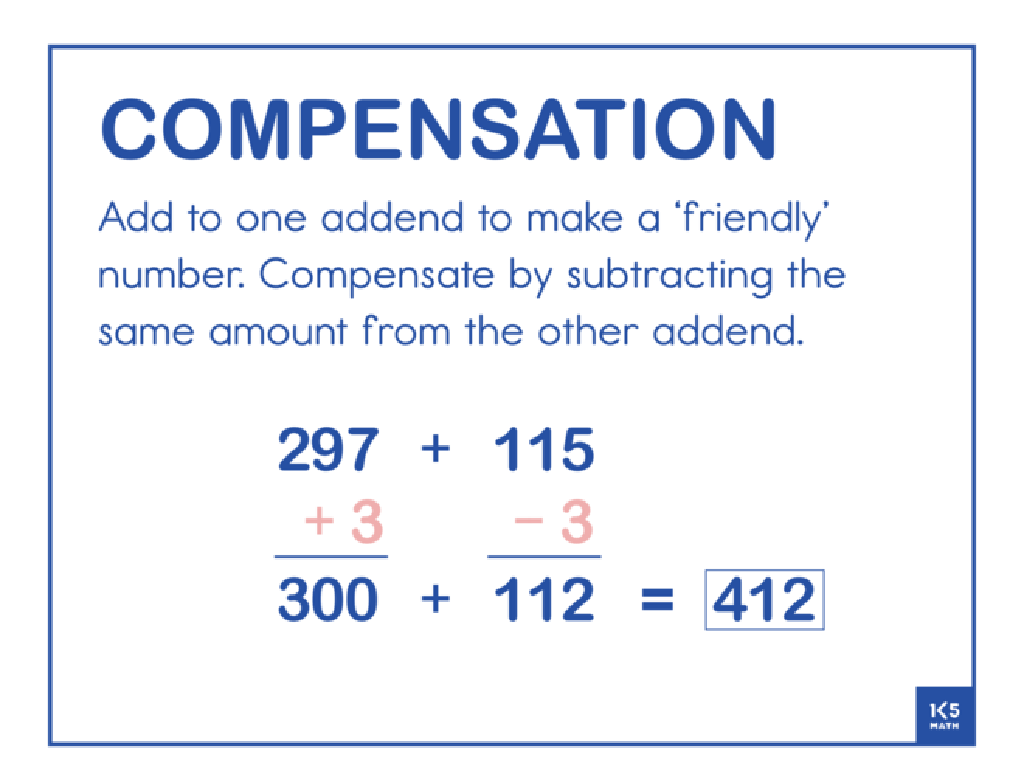Write A Linear Equation From A Slope And Y-Intercept
Subject: Math
Grade: Eighth grade
Topic: Linear Equations
Please LOG IN to download the presentation. Access is available to registered users only.
View More Content
Writing Linear Equations
– Recap on linear equations
– Equation of a line: y = mx + b
– The formula where ‘m’ is slope and ‘b’ is y-intercept
– Identifying slope ‘m’
– Slope ‘m’ measures steepness or incline of the line
– Understanding y-intercept ‘b’
– Y-intercept ‘b’ is where the line crosses the y-axis
|
Begin with a brief review of what the class has previously learned about linear equations to refresh their memory. Then, introduce the standard form of the equation of a line, emphasizing the roles of ‘m’ (slope) and ‘b’ (y-intercept). Explain that the slope represents the rate of change between the x and y variables, and the y-intercept is the point where the line crosses the y-axis when x is zero. Use examples to illustrate how different values of ‘m’ and ‘b’ affect the position and angle of the line on a graph. Encourage students to practice by identifying ‘m’ and ‘b’ in various linear equations and to predict the shape and position of the corresponding lines.
Understanding Slope in Linear Equations
– Define slope: rate of change
– Slope measures steepness or incline of a line, represented as ‘m’
– Positive vs. Negative slope
– Positive slope rises to the right, negative falls to the right
– Zero and Undefined slopes
– Zero slope is flat, undefined is a vertical line
– Real-life slope examples
– Elevation gain in hiking, cost increase over time
|
This slide introduces the concept of slope, which is a fundamental element in writing linear equations. Slope, often denoted as ‘m’, represents the rate at which the y-value of a point on a line changes with respect to its x-value. A positive slope indicates an upward trend, while a negative slope indicates a downward trend. Zero slope means the line is horizontal, and an undefined slope means the line is vertical. Real-life examples, such as the rate of elevation gain during a hike or the rate of cost increase over time, can help students grasp the concept of slope. Encourage students to visualize these scenarios and relate them to the slope of a line on a graph. This understanding is crucial for writing linear equations from a slope and a y-intercept.
Understanding Y-Intercept in Linear Equations
– Define y-intercept
– The point where the line crosses the Y-axis
– Finding y-intercept on a graph
– Look for where the line meets the Y-axis at y = c
– Y-intercept’s role in equations
– It represents the starting value when x is zero
– Writing equations with y-intercept
– Use the formula y = mx + b, where b is the y-intercept
|
The y-intercept is a fundamental concept in understanding linear equations. It is the point where the line crosses the vertical Y-axis, which can be found by looking at the graph where x equals zero. The y-intercept is significant because it represents the starting value of the dependent variable when the independent variable is zero. When writing linear equations in the slope-intercept form, y = mx + b, the y-intercept is denoted by ‘b’. It’s essential for students to grasp this concept as it aids in graphing linear equations and understanding the equation’s context in real-world situations. Encourage students to practice by identifying the y-intercept in various linear equations and graphing them accordingly.
Writing Linear Equations from Slope and Y-Intercept
– Equation form: y = mx + b
– Example with m = 2, b = -3
– The line equation is y = 2x – 3
– Graph interpretation for m and b
– Find slope (rise over run) and y-intercept (where line crosses y-axis)
– Practice writing equations
– Use different values of m and b to write your own equations
|
This slide introduces the concept of writing linear equations using the slope-intercept form, where ‘m’ represents the slope and ‘b’ the y-intercept. Start by explaining the formula y = mx + b. Use the example provided to show how to plug in the values of m and b to form the equation of a line. Then, guide students on how to identify the slope and y-intercept from a graph, emphasizing the visual interpretation of these components. Finally, encourage practice by having students write equations from given slopes and y-intercepts, and from graphs they interpret themselves. This will solidify their understanding and prepare them for more complex problems.
Practice: Writing Linear Equations
– Write equations from slope & y-intercept
– Use the formula y = mx + b, where m is slope and b is y-intercept
– Convert graphs to linear equations
– Identify the slope and y-intercept from the graph to form the equation
– Group activity: Matching game
– Groups will match given equations with the correct graphs on the board
– Review and discuss solutions
|
This slide is focused on practice problems to reinforce the concept of writing linear equations from a slope and y-intercept. Students will apply the formula y = mx + b, where ‘m’ represents the slope and ‘b’ the y-intercept, to write the equation. They will also practice converting information from a graph into a linear equation by identifying the slope and y-intercept visually. The group activity is designed to encourage collaboration and application of the concepts learned. Each group will receive a set of equations and graphs and will work together to match them correctly. After the activity, review the answers as a class to ensure understanding. Provide guidance and additional examples as needed to clarify any misconceptions. This interactive approach helps students to solidify their understanding of linear equations in a fun and engaging way.
Real-World Applications of Linear Equations
– Linear equations model reality
– They help us understand and predict events
– Example: Profit prediction
– If a company earns $100 per product, the profit can be modeled as y = 100x
– Discuss real-life linear equations
– Think about budgeting, construction, or science experiments
– Share findings with the class
|
This slide aims to show students the practical applications of linear equations in everyday life. Start by explaining how linear equations can model various situations, such as changes over time or distance. Use an example like predicting profits to make it tangible; if a company earns a fixed amount per product sold, the total profit can be predicted with a linear equation. Encourage students to discuss with a partner where they’ve encountered linear equations outside of school, such as in budgeting their allowance, measuring materials for a project, or observing scientific data. This discussion will help them connect classroom math to the real world. After the discussion, ask students to share their examples to foster a collaborative learning environment.
Class Activity: Crafting Linear Equations
– Choose a slope and y-intercept
– Graph the equation on a plane
– Plot the y-intercept, then use the slope to find other points
– Present and explain your graph
– Share your equation’s graph with the class
– Discuss the significance of slope and intercept
– How does changing the slope or y-intercept affect the line?
|
This activity is designed to solidify students’ understanding of linear equations by having them actively participate in the creation process. Students will select their own values for the slope and y-intercept, which will help them understand how these components shape the graph of the equation. Encourage creativity but also ensure that they grasp the concept that the y-intercept is where the line crosses the y-axis and the slope determines the steepness of the line. After graphing, students will present their findings to the class, explaining their thought process. This will help them articulate their understanding and learn from their peers. Possible variations for the activity could include creating equations that model real-life situations, comparing graphs of equations with the same slope but different y-intercepts, or vice versa.
Lesson Summary & Homework
– Recap: Writing linear equations
– Homework: Find a real-world linear equation
– Look for a linear equation used in a news article or website
– Explain equation components
– Identify the slope, y-intercept, and how they shape the graph
– Upcoming quiz: Study linear equations
|
As we conclude today’s lesson, ensure students have a clear understanding of how to write linear equations using the slope and y-intercept. For homework, students should find a linear equation from a real-world context, such as a news article or an online resource, and break down its components. This will help them see the practical application of what they’ve learned. Additionally, prepare them for the upcoming quiz by reviewing the key concepts and providing study materials. Encourage them to practice writing equations and identifying slopes and y-intercepts to solidify their understanding.






